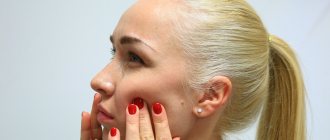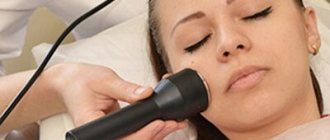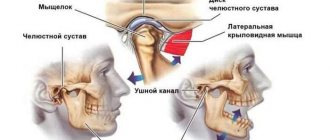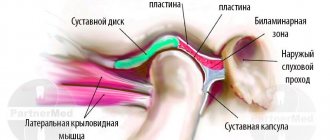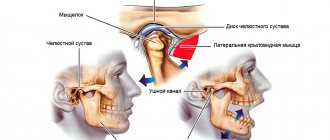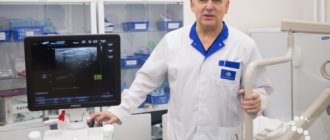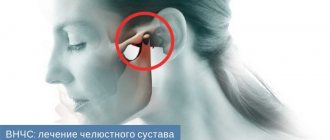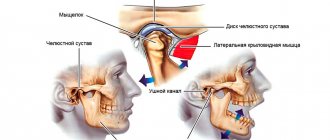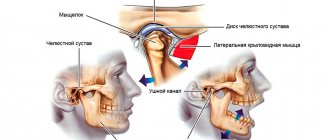The temporomandibular joint is a complex paired anatomical formation that provides horizontal and vertical movement of the lower jaw relative to the lower jaw. The load on the joint is determined not only by the quality of the food that needs to be chewed, but also by the condition of the dental system. The condition of the temporomandibular joint (TMJ) in turn affects our well-being and overall health.
According to data provided in the reports of the World Health Organization for 2022, musculo-articular dysfunction of the TMJ is detected in approximately every second person aged 20 to 50 years. And these are only those cases that are recorded in medical documentation. A fairly large number of people do not associate persistent headaches, clicking in the joints when chewing, difficulty opening the mouth with a painful condition of TMJ and are in no hurry to seek medical help.
Often, the pathology of the temporomandibular joint is detected during an examination performed for another reason, for example, in preparation for prosthetics. At the same time, the variants of joint diseases can be very different from dysfunctional syndrome to habitual joint dislocation.
Structure and functions of the temporomandibular joint
The joint is formed by the head of the horn of the lower jaw and the articular surface (fossa) of the temporal bone. Between these bone formations there is a fibrous intra-articular disc, which is fused on all sides with the joint capsule. Ligaments and muscles help keep the joint in the correct position. They limit the range of motion in the joint. Attempting to exceed this functional limitation causes pain and prevents damage to the TMJ.
The main function of the joint is to ensure movement of the lower jaw in three directions:
- vertical: opening and closing the mouth;
- horizontal: lateral displacements of the lower jaw relative to the upper;
- sagittal: movement of the lower jaw back and forth relative to the upper.
The combination of movements of one jaw relative to the other allows us to chew, speak, and express emotions through facial expressions.
Symptoms of TMJ pathology
Symptoms of TMJ diseases include a large number of different manifestations, from painful sensations and unpleasant sounds to difficulty opening and closing the mouth. Let's look at the main signs that help identify TMJ pathologies.
- Pain syndrome . The pain can be localized not only in the area of the joint itself, but also spread to the head, temple area, and cervical region. Some patients may complain of soreness in the ears, heaviness in the head, pressure and pain in the eye area. Discomfort can manifest itself in a calm state and when moving the lower jaw.
- Impaired mobility . Restriction of TMJ mobility is also called “blocking”, “locking”, “jamming” of the joint. When the joint is blocked, the patient notes difficulty opening and closing the mouth. The structures of the articular joints operate in a disrupted manner, so the movements of the joint are uneven, as if it “gets stuck”, catching the optimal position.
- Sound signs . Clicking, crunching, and crackling sounds are one of the most common complaints among patients with TMJ pathologies. Crepitation (a characteristic crunching sound) occurs when the mouth is opened wide (for example, when yawning), chewing food, and even when swallowing. In some cases, the sound is so expressive that it can be heard from the outside.
- Other symptoms . With TMJ pathology, other manifestations of the disease also make themselves felt: disturbed sleep, snoring, dizziness, bruxism. The presence of swelling and painful sensations on palpation may indicate an acute form of the disease and the development of the inflammatory process.
The method of examining patients with TMJ pathologies includes, first of all, the study of complaints, palpation (a physical method of medical diagnosis carried out by feeling the area under study) and auscultation (a diagnostic method that involves listening to the sounds generated during the functioning of the organ under study) of the joint area.
Causes of dysfunction of the masticatory joints
A gnathologist specializes in the diagnosis and treatment of TMJ diseases. In fact, this is a dentist with a narrow specialization. Factors that can lead to temporomandibular joint disease include:
- vascular pathology, which leads to impaired blood supply to the joint;
- increased tone of the muscles of the face and neck (increased tone, spasms);
- violation of occlusion;
- manifestations of psychosomatics.
Occlusion disorders underlie the largest number of cases of TMJ disease. Normally, the antagonist teeth of the upper and lower jaws contact their chewing surfaces in a certain way. The cusps and depressions on the upper surface of the antagonist teeth should contact according to the “pestle and mortar” principle. If the teeth on the jaw are positioned incorrectly and their correct contact is impaired, compensatory mechanisms are activated. In particular, the tone of the chewing muscles changes and the lower jaw shifts in such a way as to achieve full contact of all chewing surfaces of the teeth.
This displacement eliminates the occlusal obstacle, but creates additional stress on the temporomandibular joint. Habitual displacement of the jaw over time leads to damage to the anatomical structures of the joint. Increased tone of the masticatory muscles provokes hemodynamic disturbances in the TMJ area, which does not contribute to rapid regeneration.
If the cause of unpleasant symptoms in the TMJ area is a violation of occlusion, a gnathologist may recommend orthodontic treatment. This is the only way to get rid of the problem, since if the teeth are incorrectly positioned on the jaw, only symptomatic treatment of TMJ problems can be carried out, which will only lead to a temporary improvement in the condition.
How does pathology develop?
Regular exposure to negative factors leads to gradual dysfunction of the joint. At the initial stage of pathology development, these processes are reversible. Arthrosis develops when the load on the joint becomes greater than its endurance.
Incorrect bite and missing teeth can cause displacement of the jaw head. This leads to a disruption in load distribution. In addition, the nutrition and functionality of the joint are also impaired. Over time, the cartilage on the surface of the joint head begins to deteriorate.
Cysts may begin to grow in the bone apparatus. Over time, the head of the joint becomes deformed.
Symptoms and prevention of TMJ dysfunction
Pain in the masticatory joint is an extremely rare occurrence. In this regard, patients rarely associate the existing pathological manifestations with the condition of the TMJ. Let's see what symptoms you need to make an appointment with a gnathologist:
- Headache. There are a great many causes of headaches, but the “contribution” of the temporomandibular joint is most often “forgotten” by specialists. Elimination of TMJ pathology often relieves a person of headaches.
- Clicking in the joint. The characteristic sound when opening the mouth is a consequence of dislocation or subluxation of the masticatory joint, which usually resets on its own.
- Limitation of mouth opening. This may be a consequence of swelling of the joint tissue as a result of the development of an inflammatory process or dislocation of the joint.
- Pathological abrasion of tooth enamel.
Measures to prevent the development of TMJ dysfunction include regular visits to the dentist, rational prosthetics, timely treatment and restoration of damaged teeth, and orthodontic treatment as indicated.
Diagnosis
The diagnosis of this disease can only be made by an orthopedic dentist based on an x-ray. If necessary, a blood test and consultation with a dentist or other specialized specialists are prescribed to identify concomitant diseases. You may need the help of a dentist, orthodontist, rheumatologist, endocrinologist, immunologist, etc.
Based on the results of X-ray diagnostics and general examination, the doctor can refer the patient to an orthodontist to eliminate bite pathology, which puts an improper load on the joint. To treat inflammation of the joint, you will need to consult a rheumatologist; to remove growths or plastic surgery of the joint, the patient is referred to a surgeon; to normalize metabolism, you need the help of an endocrinologist. It is also advisable to add massage to improve blood supply to the joint tissues and prescribe physical therapy.
Diagnostics
In order to make a diagnosis, the doctor conducts an examination according to the following scheme:
- Questioning the patient. Of interest to the specialist are complaints, conditions for the appearance of unpleasant symptoms, duration of the disease, previous treatment and its effectiveness.
- External examination and palpation. The gnathologist examines the patient’s face, paying attention to the area where the TMJ is located. By feeling the joints, you can get an idea of its structure and the state of its tissues.
- Dental examination. Anomalies of occlusion and the degree of their severity are identified.
- X-ray examination. The photographs show the bone formations that form the joint. By their relative position one can determine the presence of dislocations and subluxations, and by the thickness of the joint space one can judge the condition of the cartilaginous disc.
Causes
There are many reasons for the development of TMJ neoarthrosis. First of all, these are congenital malformations, when the disease develops almost from the first days of life.
The second reason is secondary deforming osteoarthritis. This pathology is recorded in the first year of life, and there is such a noticeable feature as underdevelopment of all parts of the lower jaw.
The third is bone ankylosis, which manifests itself in the first years of life. Also, the causes of the disease include habitual subluxation, which occurs at the age of 10–15 years, as well as the development of chronic arthritis and deforming arthrosis.
Treatment
A gnathologist can carry out treatment either independently or with the involvement of specialists from other fields. This is especially true when the cause of the development of TMJ pathology has been identified and can be eliminated. The help of an orthodontist is necessary for patients with malocclusion. Wearing a brace system or aligners to correct occlusion has a beneficial effect on the condition of the entire dental system.
Detection of arthrosis or ankylosis of the temporomandibular joint also requires the involvement of specialized specialists. The doctor's specialty will be determined by the cause of the development of degenerative-dystrophic processes in the tissues of the TMJ. Metabolic disorders, injuries, infections will require additional examination and the development of an individual treatment plan.
Causes
Arthrosis of the TMJ is divided into primary and secondary. With primary arthrosis, changes occur in a healthy joint, mainly in people over 50 years of age. With secondary arthrosis, a joint that is already damaged after injury, malocclusion or inflammation of the joint is deformed. The causes of arthrosis include:
- improper prosthetics;
- missing teeth, tooth wear;
- unsuccessful jaw surgery;
- inflammation of the joint due to chronic diseases, for example, rheumatic diseases;
- metabolic disorder in the body.
First aid
A joint dislocation or subluxation that occurs for the first time can cause severe pain. Joint dysfunction can also cause pain of the same intensity. Regardless of the cause of the discomfort, you must do the following:
- provide rest to the joint: do not eat, talk as little as possible;
- take a pain reliever;
- Consult a doctor as soon as possible and undergo the necessary examination.
Experts categorically do not recommend heating a sore joint if the cause of the pain is unknown. In case of dysfunction, heat exposure can lead to some relief of the condition, but in case of dislocation, on the contrary, it will cause harm. Under the influence of heat, blood flow to the tissue increases, which contributes to the development of edema and makes reduction difficult. Thus, when trying to help yourself or a loved one, you can unknowingly cause serious harm.
Osteoarthritis of the TMJ
The symptoms that osteoarthritis of the temporomandibular joint may manifest depend on the form in which the disease occurs. With post-infectious arthrosis, we are dealing with the consequences of acute inflammatory and infectious processes. As mentioned above, the clinic may be asymptomatic and the disease can be diagnosed by X-ray examination of the maxillofacial area for some other reason. When a chronic injury worsens, the patient experiences severe pain and discomfort, especially when chewing and swallowing food. The x-ray shows areas of bone dissolution, accompanied by defects and damage to the surfaces of the joints.
If the cause of deforming arthrosis is jaw injuries (post-traumatic arthrosis), limited distribution or localization in the bone tissue occurs. The pain syndrome may not appear; instead, the patient has problems opening the mouth, and a characteristic clicking sound is observed when eating. After an X-ray examination, areas of local increase in bone tissue in volume both in the joint bed and in the adjacent soft tissues become noticeable. Visually, the disease manifests itself in the form of a pronounced displacement of the structures of the face and lower jaw when trying to open the mouth. Due to the unilateral development of the pathological process, the chin begins to shift towards the healthy side of the face.
Myogenic osteoarthritis is a type of pathology in which the bone grows in the shape of a beak. This occurs due to an atypical contraction of the pterygoid muscle of the head with uncoordinated periodic muscle movement and reorientation of bone structures. This type of disease also occurs without any special symptoms, and localized dull pain can be caused by incoordination of muscle movements or chronic subluxations of the jaw joint.
Much less common are metabolic arthrosis, provoked by metabolic disturbances with the deposition of uric acid on the surfaces of large joints (gout). Palpation allows the doctor to identify significant deformation of the head of the joint in the affected area. To correctly make a final diagnosis, the attending physician consults with related specialists - a therapist and an endocrinologist.
Symptoms
The main pronounced symptom is considered to be growth retardation of the lower jaw. This is especially noticeable when only one side of the face is affected. Parents notice this deformation too late.
As a result of underdevelopment of the bones, the chin shifts to the right or left. The contours of the affected half of the face are very rounded, which is due to the large amount of soft tissue, in this case it will be the cheek. The corner of the mouth on the affected half is shifted downward.
Often, it is precisely this symptom that leads to the development of a diagnostic error and the child is given an incorrect diagnosis, which most often sounds like facial nerve paresis. This entails the prescription of inadequate treatment, which does not stop the bone-destroying process.
Symptoms of TMJ ankylosis
Depending on the individual physiological structure, patients may experience one of the two most pronounced symptoms of TMJ arthrosis:
- a constant feeling of mild pain combined with extraneous noises of an unnatural nature;
- clicking or crunching in the area of the arthrosis joint.
Quite often, patients notice the presence of constant aching pain. The pain syndrome is characterized by a temporary increase in the period of physical activity on the affected joint (for example, during conversation or chewing movements). In the morning or after a long period of rest, a person feels stiffness in jaw movements; some experience a visible displacement of the jaw towards the diseased joint. A person can chew food only on one side (healthy) due to the fact that chewing movements on both sides of the jaw cause severe pain.
The nature of the pathological process is long-term, due to the presence of various processes in the anamnesis. These include the following:
- inflammatory processes in the joint;
- various types of injuries;
- dentofacial operations;
- abnormalities of teeth, including their abrasion;
- incorrect prosthetics, resulting in damage to the jaw;
- main symptoms of TMJ arthrosis;
- increased pain during physical activity;
- violation of facial symmetry;
- characteristic clicking or crunching sounds in the area of the affected joint;
- the presence of flattening on palpation.
Correct diagnosis of the disease consists of a comprehensive instrumental examination of the patient, which allows, based on the clinical picture and examination results, not only to establish the correct diagnosis, but also to perform the correct treatment.

